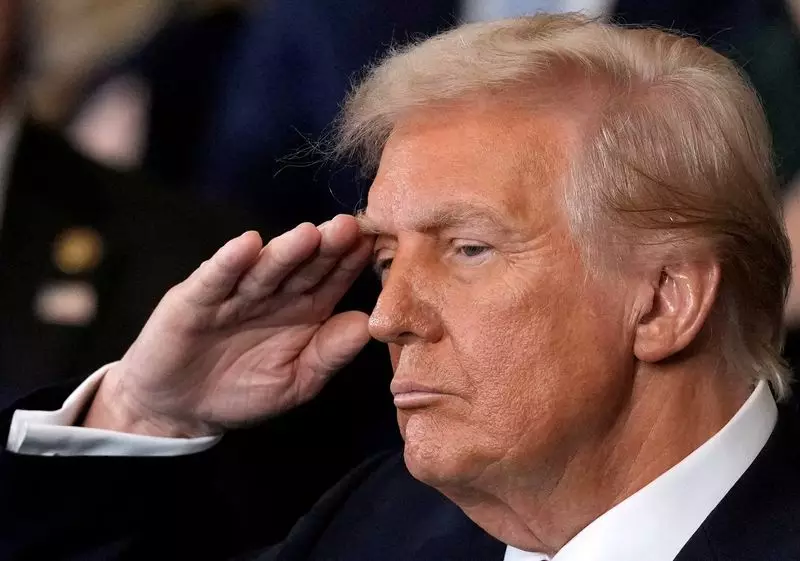In a world rife with unpredictable economic dynamics, President Donald Trump’s approach to trade has been a focal point for many analysts and stakeholders. A recent memo from the Trump administration outlines a steadfast strategy that, rather than imposing immediate tariffs, calls for a more nuanced examination of the United States’ trade relationships with key partners such as China, Canada, and Mexico. This evolving trade stance reflects a balancing act between addressing longstanding trade deficits and maintaining market stability.
When the news broke regarding Trump’s trade memo, financial markets reacted sharply. With the absence of immediate tariff announcements, investors expressed noticeable relief, leading to a rally in global stock indices and a decline in the value of the U.S. dollar against major currencies, particularly the euro, Canadian dollar, Mexican peso, and Chinese yuan. The market response underscores the intricacies involved in trade policies—investors often prefer cautious strategies over abrupt policy shifts that could destabilize economic conditions.
The significance of the memo lies not merely in what it states but also in its implications for U.S. trade relationships. By steering away from swift tariff impositions on his first day in office—a move that many anticipated—Trump is indicating a deliberate assessment of the U.S.’s current trade standing. This cautious approach contrasts sharply with his earlier campaign promises to impose immediate high tariffs on imports, notably those from China, and signals an inclination to gather more data and input before making significant decisions that could unsettle the economic landscape.
According to a Trump administration official, the memo will direct federal agencies to investigate the trade practices of China, Canada, and Mexico, focusing on persistent trade deficits and perceived unfair practices. Instead of wielding tariffs as a blunt instrument, Trump’s plan encourages extensive scrutiny of both domestic and international trade practices, signaling a more methodical exploration of trade policy. This approach could pave the way for tailored solutions targeted at specific issues rather than blanket tariffs which could affect a broader spectrum of economic actors.
Trade experts suggest that this shift reflects strategic consideration. Some analysts previously speculated that Trump might invoke emergency powers to implement tariffs quickly. However, the strategy outlined in the memo suggests a preference for investigations under established trade statutes, such as Section 232 and Section 301, which have been used in previous trade policies. This could lead to more nuanced and potentially collaborative resolutions that address specific grievances while minimizing economic disturbance.
Trump’s original administration engaged aggressively in trade negotiations and tariffs, which sparked a significant confrontation with China, resulting in a highly publicized trade war. The implications of these earlier policies are pervasive, as evidenced by the ongoing discussions surrounding commitments made during the initial trade agreement with China. Analysts believe that Trump is utilizing the forthcoming memo not just to reinforce existing policies, but also to hold partner nations accountable for following through on prior agreements regarding U.S. exports.
During his first term, Trump’s administration utilized investigations to impose tariffs on steel and aluminum imports and rolled out duties on a vast array of Chinese products. The mixed success of those strategies, marked by retaliatory tariffs and market disruptions, presents a complicated legacy. As Trump restarts his second term, it signals a continuity in methodology while adjusting tactics to mitigate immediate backlash.
Going forward, the complexity of international trade relationships demands an approach that combines aggressive negotiation with astute economic management. By temporarily stepping back from swift tariff impositions, Trump may be listening to advice from advisors about the potential negative implications of immediate actions on the financial landscape. Trade analysts now speculate about the possibility of Trump pushing for a universal tariff as a long-term goal, perhaps as a mechanism to fulfill his electoral promises.
This evolving trade strategy positions Trump amidst a tricky balancing act: advocating for American interests while ensuring that economic frameworks stay intact both domestically and internationally. The ability to navigate these waters will be paramount in determining the effectiveness of his administration’s efforts to redefine trade dynamics and achieve the broader objective of revitalizing American manufacturing.
Trump’s trade memo represents a strategic recalibration in response to both domestic and global economic signals. By opting for evaluations and investigations over immediate tariffs, the administration seeks to navigate a complex set of trade relationships with caution, aiming to reinforce American competitiveness while avoiding market instability.

